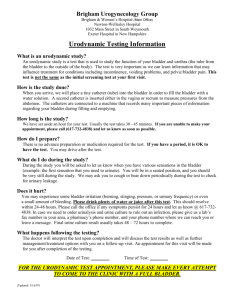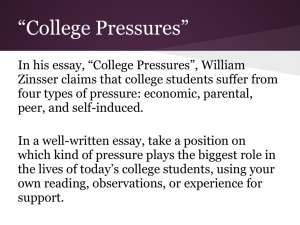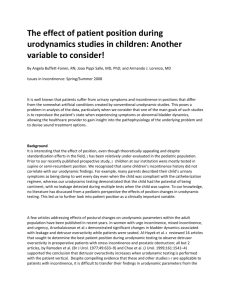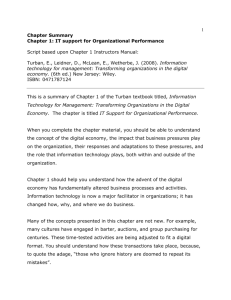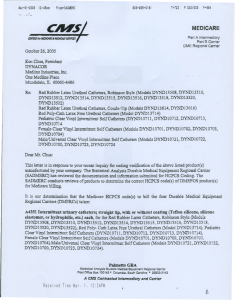Document 11129558
advertisement
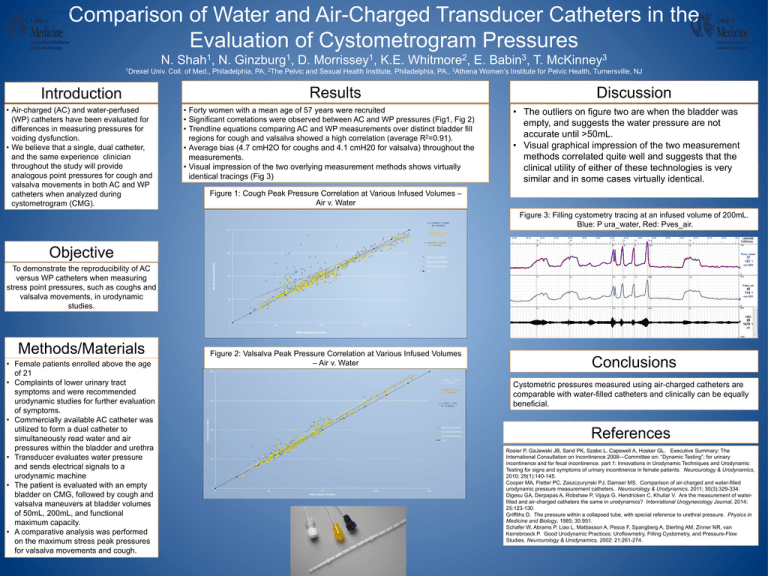
Comparison of Water and Air-Charged Transducer Catheters in the Evaluation of Cystometrogram Pressures N. 1Drexel 1 Shah , 1 Ginzburg , N. D. 1 Morrissey , K.E. 2 Whitmore , E. 3 Babin , T. 3 McKinney Univ. Coll. of Med., Philadelphia, PA, 2The Pelvic and Sexual Health Institute, Philadelphia, PA., 3Athena Women’s Institute for Pelvic Health, Turnersville, NJ • Air-charged (AC) and water-perfused (WP) catheters have been evaluated for differences in measuring pressures for voiding dysfunction. • We believe that a single, dual catheter, and the same experience clinician throughout the study will provide analogous point pressures for cough and valsalva movements in both AC and WP catheters when analyzed during cystometrogram (CMG). Discussion Results Introduction • Forty women with a mean age of 57 years were recruited • Significant correlations were observed between AC and WP pressures (Fig1, Fig 2) • Trendline equations comparing AC and WP measurements over distinct bladder fill regions for cough and valsalva showed a high correlation (average R2=0.91). • Average bias (4.7 cmH2O for coughs and 4.1 cmH20 for valsalva) throughout the measurements. • Visual impression of the two overlying measurement methods shows virtually identical tracings (Fig 3) • The outliers on figure two are when the bladder was empty, and suggests the water pressure are not accurate until >50mL. • Visual graphical impression of the two measurement methods correlated quite well and suggests that the clinical utility of either of these technologies is very similar and in some cases virtually identical. Figure 1: Cough Peak Pressure Correlation at Various Infused Volumes – Air v. Water y = 0.7844x + 32.586 R² = 0.64075 Figure 3: Filling cystometry tracing at an infused volume of 200mL. Blue: P ura_water, Red: Pves_air. 200 y = 0.8947x + 10.203 R² = 0.9479 y = 0.9029x + 11.803 R² = 0.93254 Objective 150 Beginning (0-50mL) Air pressure (cmH20) Mid-test (200-250mL) To demonstrate the reproducibility of AC versus WP catheters when measuring stress point pressures, such as coughs and valsalva movements, in urodynamic studies. Functional Capacity Y=X 100 50 0 0 50 100 150 200 Water pressure (cmH20) Methods/Materials 200 y = 1.0686x + 1.1259 R² = 0.90418 y = 1.0381x + 0.1033 R² = 0.97424 150 y = 1.0724x - 2.426 R² = 0.96584 Air pressure (cmH20) • Female patients enrolled above the age of 21 • Complaints of lower urinary tract symptoms and were recommended urodynamic studies for further evaluation of symptoms. • Commercially available AC catheter was utilized to form a dual catheter to simultaneously read water and air pressures within the bladder and urethra • Transducer evaluates water pressure and sends electrical signals to a urodynamic machine • The patient is evaluated with an empty bladder on CMG, followed by cough and valsalva maneuvers at bladder volumes of 50mL, 200mL, and functional maximum capacity. • A comparative analysis was performed on the maximum stress peak pressures for valsalva movements and cough. Figure 2: Valsalva Peak Pressure Correlation at Various Infused Volumes – Air v. Water Beginning (0-50mL) 100 Mid-test (200-250mL) Functional Capacity Y=X 50 0 0 50 100 Water pressure (cmH20) 150 200 Conclusions Cystometric pressures measured using air-charged catheters are comparable with water-filled catheters and clinically can be equally beneficial. References Rosier P, GaJewski JB, Sand PK, Szabo L, Capewell A, Hosker GL. Executive Summary: The International Consultation on Incontinence 2008—Committee on: “Dynamic Testing”; for urinary incontinence and for fecal incontinence. part 1: Innovations in Urodynamic Techniques and Urodynamic Testing for signs and symptoms of urinary incontinence in female patients. Neurourology & Urodynamics, 2010; 29(1):140-145. Cooper MA, Fletter PC, Zaszczurynski PJ, Damser MS. Comparison of air-charged and water-filled urodynamic pressure measurement catheters. Neurourology & Urodynamics, 2011; 30(3):329-334. Digesu GA, Derpapas A, Robshaw P, Vijaya G, Hendricken C, Khullar V. Are the measurement of waterfilled and air-charged catheters the same in urodynamics? Intenrational Urogynecology Journal, 2014; 25:123-130. Griffiths D. The pressure within a collapsed tube, with special reference to urethral pressure. Physics in Medicine and Biology, 1985; 30:951. Schafer W, Abrams P, Liao L, Mattiasson A, Pesce F, Spangberg A, Sterling AM, Zinner NR, van Kerrebroeck P. Good Urodynamic Practices: Uroflowmetry, Filling Cystometry, and Pressure-Flow Studies. Neurourology & Urodynamics, 2002: 21:261-274.
